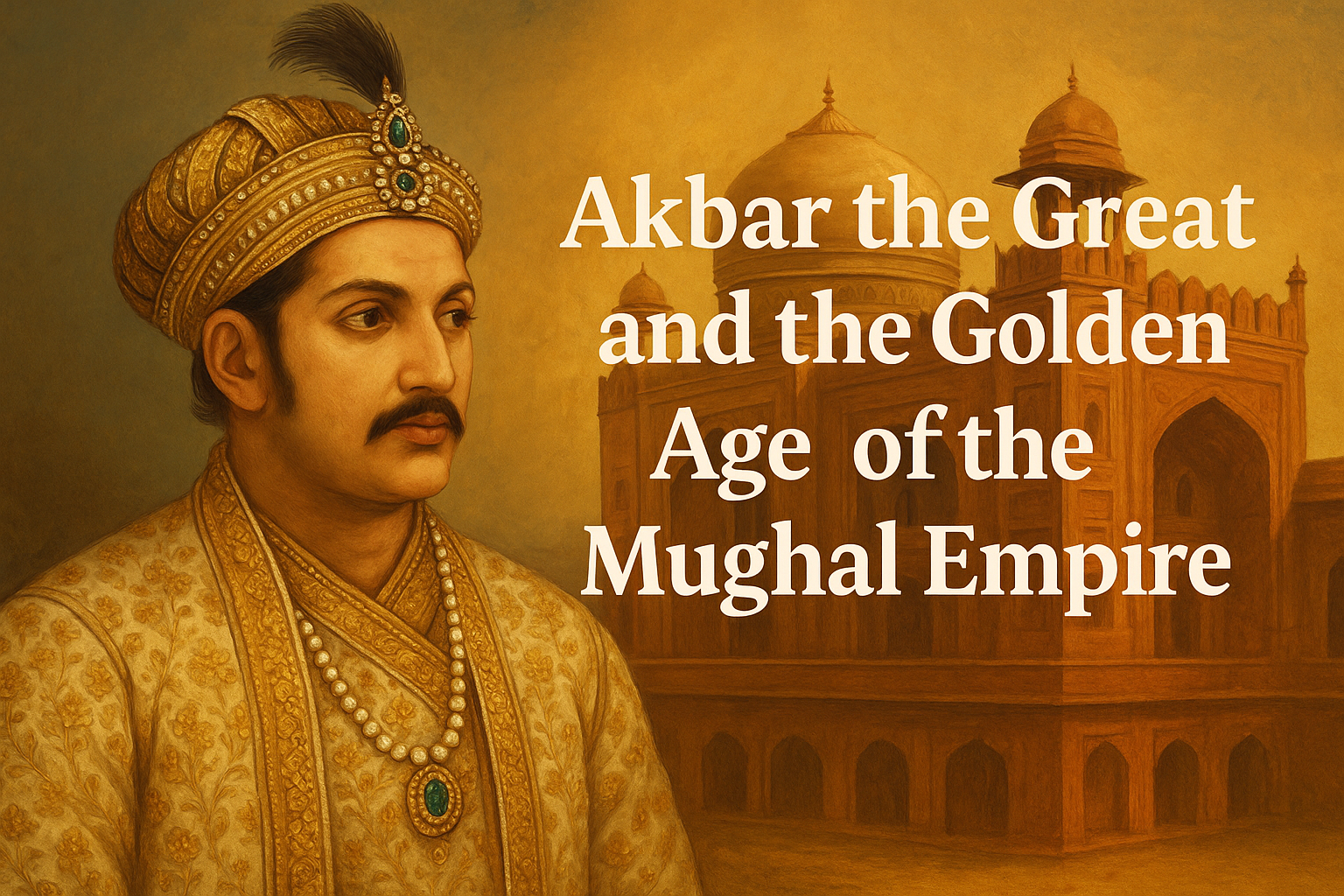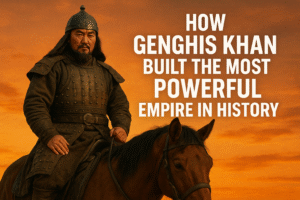Akbar the Great transformed the Mughal Empire into a powerhouse of culture, tolerance, and conquest. Discover the ruler who shaped India’s history forever.
- A Young Emperor Who Inherited A Fragmented Empire
- Conquests That Expanded And Secured The Empire
- A Policy Of Religious Tolerance That Redefined Empire
- Administrative Reforms That Revolutionised Governance
- A Patron Of Art, Culture And Intellectual Exchange
- The Legacy Of A Ruler Who Redefined Kingship
- Follow My Journey And Get Inspired To Transform Your Life For The Better
A Young Emperor Who Inherited A Fragmented Empire
When Jalal-ud-din Muhammad Akbar was born in 1542 in Umerkot, little could anyone imagine he would go on to become one of the greatest rulers in South Asian history. He was only 13 when he ascended the throne after the untimely death of his father, Humayun, the second emperor of the Mughal dynasty. At the time, the empire was in disarray, fragmented by internal divisions, external threats, and regional rivals vying for power.
Akbar’s early reign was overseen by the wise and loyal regent Bairam Khan, who acted as a mentor and protector. Under Bairam’s leadership, Akbar began consolidating power. But the real transformation happened once Akbar came of age and took direct control. He quickly displayed political acumen far beyond his years. He didn’t just want to rule – he wanted to unite.
India, during the 16th century, was a vast mosaic of languages, religions, and kingdoms. Akbar realized that the only way to build a lasting empire was not through brute force alone, but through integration and inclusion. It was a radical vision at the time, but one that would define his legacy.
Conquests That Expanded And Secured The Empire
One of Akbar’s most remarkable achievements was his military prowess. While he was a visionary, he was also a seasoned warrior. His empire expanded rapidly through a series of calculated conquests and strategic alliances. He subdued Rajput kingdoms, annexed Gujarat and Bengal, and laid the foundations for what would become one of the largest empires in Indian history.
Unlike many conquerors, Akbar didn’t annihilate the defeated. Instead, he often allowed local rulers to retain their titles and positions in exchange for loyalty to the Mughal throne. This policy of conciliation was revolutionary. It reduced rebellion and fostered cooperation.
His military campaigns were supported by a strong and disciplined army, equipped with advanced artillery and led by experienced generals. But even here, Akbar innovated. He introduced a merit-based system for promotions and encouraged a diverse leadership comprising Hindus, Muslims, and even Persians.
Akbar’s most famous military victory came at the Second Battle of Panipat in 1556, just months after taking the throne. Facing a much larger army led by the Afghan chieftain Hemu, the young emperor’s forces, under Bairam Khan, won a decisive victory. This battle was a turning point and secured the Mughal presence in northern India.
A Policy Of Religious Tolerance That Redefined Empire
Perhaps the most defining feature of Akbar’s reign was his religious policy. Living in a deeply divided subcontinent, Akbar chose a path few rulers dared to walk – he pursued religious tolerance not just in rhetoric, but in practice.
He abolished the jizya tax that non-Muslims were forced to pay under Islamic rule, promoted interfaith dialogue, and included Hindus in his court at the highest levels. His inner circle included not only Muslims but Rajputs, Jains, and Christians.
Akbar even went a step further and created a unique religious-philosophical movement known as Din-i Ilahi (Religion of God). While it never became a mass movement, its symbolism was powerful – a call for spiritual unity above dogma. He invited scholars from all religions to engage in debates at his palace in Fatehpur Sikri, reflecting his genuine curiosity and desire for understanding.
This policy of religious harmony allowed the Mughal Empire to maintain internal peace and gain loyalty from diverse subjects. It was not just idealism—it was strategic genius. By reducing sectarian conflict, Akbar strengthened the foundations of his empire.
Administrative Reforms That Revolutionised Governance
Akbar wasn’t just a conqueror and philosopher-king; he was a master administrator. He transformed the Mughal bureaucracy into one of the most efficient systems the Indian subcontinent had ever seen. His reforms touched every level of governance and helped establish a stable, prosperous empire.
At the heart of his administration was the mansabdari system, a military and bureaucratic ranking structure. This system ensured that officials were graded according to their merit and loyalty, not just their lineage. It created a clear hierarchy and incentivized performance.
Akbar also introduced land revenue reforms that changed how taxes were assessed and collected. His finance minister, Raja Todar Mal, developed a standardized system for revenue collection based on land productivity. These reforms increased state income while reducing corruption and exploitation.
Another innovation was the creation of a centralized record-keeping system. For the first time, officials had to maintain detailed records of taxes, crop yields, and population. This data-driven approach allowed for better decision-making and minimized arbitrary rule.
Akbar also emphasized infrastructure – building roads, fortresses, and rest houses for travelers. His focus on public works helped trade flourish across the empire and connected distant regions to the capital.
A Patron Of Art, Culture And Intellectual Exchange
While Akbar’s conquests and governance were impressive, his contributions to culture were equally transformative. He turned the Mughal court into a beacon of art, literature, and innovation. Under his rule, the fusion of Persian, Indian, and Central Asian styles gave birth to a distinctive Mughal aesthetic.
Akbar commissioned the translation of numerous Sanskrit texts into Persian, the administrative language of the empire. These included the Mahabharata, Ramayana, and various works on science and philosophy. This cultural exchange enriched Mughal thought and bridged civilizational divides.
The emperor was also a great patron of miniature painting, architecture, and music. Mughal miniatures flourished under his reign, with court artists producing stunning visual narratives. His palaces—like the stunning Fatehpur Sikri and the Agra Fort—are masterpieces of Indo-Islamic architecture.
Akbar himself was illiterate, but he was far from ignorant. He surrounded himself with intellectuals, poets, historians, and theologians. His court became a meeting place for minds, where Persian poets conversed with Hindu scholars, and Jesuit priests discussed theology with Sufi mystics.
This environment of curiosity and expression gave rise to what many consider the Golden Age of the Mughal Empire—a time when tolerance, art, and power coexisted.
The Legacy Of A Ruler Who Redefined Kingship
Akbar’s death in 1605 marked the end of an era, but his influence didn’t fade. He left behind an empire that was more cohesive, tolerant, and sophisticated than the one he inherited. His successors, especially Jahangir and Shah Jahan, would benefit from the solid foundations he laid.
But Akbar’s true legacy was not just territorial. It was ideological. He redefined what it meant to be a ruler in a diverse and complex land. His reign demonstrated that strength could coexist with compassion, that an empire could thrive not by erasing differences but by embracing them.
Today, Akbar is remembered not just as a Mughal emperor, but as a symbol of unity in diversity. In a world often torn by sectarianism and division, his life offers a powerful lesson in the value of inclusion, open-minded leadership, and ethical governance.
Even centuries after his death, Akbar remains a giant of history—not just for what he conquered, but for what he imagined and built. His story is not just the story of an emperor, but the story of a vision that dared to bring people together in pursuit of a shared future.
I am working on building a passive income stream using the internet. If you would like to do the same take a look at this business by clicking here.
This business can be operated using the internet and the start up cost is low. I don’t have to leave my current employment to work on building this global business.
If you like what you see, work with me to build a passive income stream using this global business.
I do not provide personal investment or financial advice and I am not a qualified licensed investment advisor. I am documenting my online investment and financial journey and what’s working for me. Click Here to read disclaimer.
If you found value in this post and want to support my work, click here to buy me a coffee.
Subscribe to my list for valuable updates, tools, videos and articles that I will share as I come across them.
Let me know your thoughts on this post via the comments section. You can also add your insights and suggestions.
If you enjoyed reading this post or it added some value, please share it with others.

Follow My Journey And Get Inspired To Transform Your Life For The Better
“I may earn commissions as an affiliate from sponsored links within this post”





